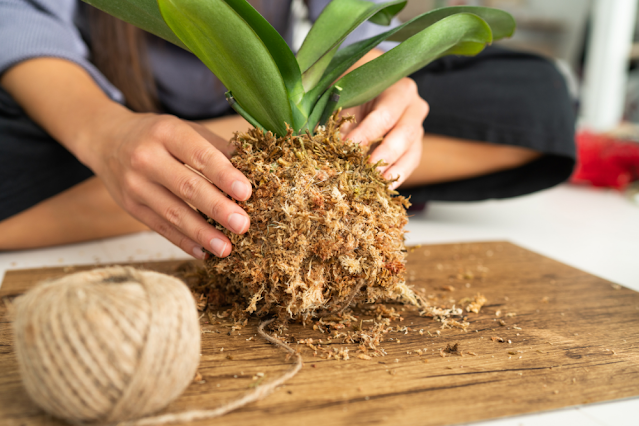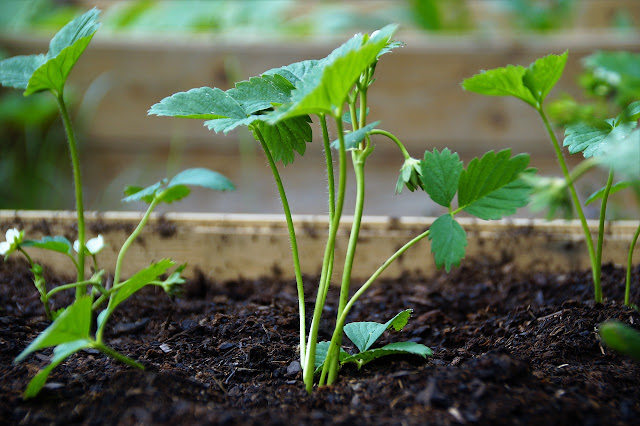Kokedama (Japanese for "moss ball") is a way for growing plants in a moss ball and presenting them in a dish or hanging in the air. The design is based on a centuries-old custom of displaying a bonsai specimen's exposed root ball on a plate to highlight its exquisite root system. Moss would collect on the roots over time, increasing the show.
Today, kokedama are commonly fashioned into spherical shapes and are frequently produced using houseplants rather than the conventional bonsai plant material of trees and shrubs. Kokedama have lately become particularly popular in New York City, probably as a result of their space-saving qualities—hanging kokedama do not take up important floor or shelf space.
With popular houseplants like pothos or peace lily, you may build your own simple hanging kokedama at home. Almost any plant may be used to make a kokedama, although it's ideal to select plants that are native to your area. If you live in a gloomy flat with a brick wall as your only window, you should use shade-tolerant plants like philodendron or pothos vines. Choose plants that tolerate a lot of light, such as citrus, ficus, or croton, whose leaves aren't likely to be burnt by the sun, if your location is sunny. If your home falls anywhere in the between of these two extremes, you're in luck: there are hundreds of plants that thrive in bright, indirect light.
Selecting The Best Plant
Kokedama are living works of beauty, and it's preferable to chose plants that develop slowly and have smaller root systems, since they'll be happier in the long run. Many houseplants may be moulded into Kokedama, and you'll want to pick one that will thrive in your home or office's lighting. Here are some plants to consider:
These houseplants thrive in medium to low light conditions:
- Dracaena (Dracaena spp.)
- Pothos (Pothos spp.)
- Snake Plant (Sanseveria spp.)
- Peace Lily (Spathipyllum
spp.).
If your house has brilliant indirect light, there are numerous plants to pick from. Here are a few of our personal favorites:
- Maidenhair Fern (Adiantum spp.)
- Birds Nest Fern (Asplenium spp.)
- Bromeliad (Bromeliad spp.)
- Spider Plant (Chlorophytum spp.)
- Trailing Ivy (Hedera spp.)
- Hoya (Hoya spp.)
- Staghorn Fern (Platycerium spp.)
- Inch Plant (Tradescantia spp.)
Making Kokedama Moss Balls Materials A properly constructed soil with a strong clay base that would stick to itself was required in the ancient art form. This soil is known as akadama, and it contains peat moss to help retain moisture. As a basis for the Japanese moss ball, you may buy bonsai soil or build your own using clay and 15% peat moss. You will also require after you have your soil combination.
- Sphagnum Moss in a Sheet or Loose Form
- A single 4-inch plant (see our suggestions)
- Scissors are a type of tool that is used to cut things apart.
- A little bucket or container to carry water
- Potting Soil (in a small container)
- Jute, twine, raffia twine with embedded wire, or monofilament in a narrow gauge
Follow these steps to make a kokedama at home.
Kokedama Caring
Kokedama Watering
Feeling how heavy your plant is often the greatest method to tell if it needs water. It's likely that the ball needs to be watered if it seems light. If the tips of your plant's leaves begin to brown, this is another clue that it needs to be watered. To prevent the brown from spreading, cut off any brown sections of the plant.
It's easy to water your plant: Soak the ball for 10 minutes in a bowl of room temperature water. After that, drain any excess water by placing the ball in a strainer for a few minutes. When the ball is no longer dripping, it is ready to be hung again.
Yellowing leaves and the development of mold are two signs that your plant is being overwatered or not properly drying. Don't be concerned if your plant develops mold. Simply cut off the sick leaf or wipe it clean with a warm cloth.
Moss Lighting Requirements
Kokedama, like other plants, need some light to flourish, but not too much—because the plant is moss-based, it is more prone to dry up if exposed to direct sunlight. Pick a semi-shady area in your home and keep an eye on it to extend the life of your ball.
Kokedama Fertilization
Fertilize your plant once a month to provide it with the nutrition it need. Simply use half of the recommended dosage of a water-soluble indoor plant fertilizer in your water-soaking regimen.



.png)








Comments
Post a Comment